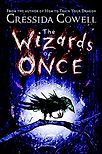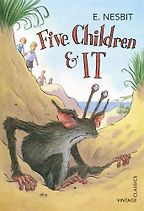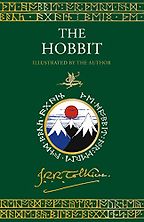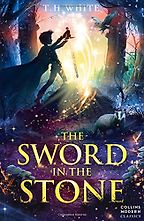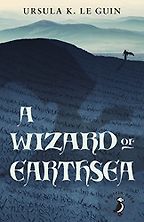Magic in children’s books is, obviously, a common theme, and while reading your choices I started to wonder, why is magic so compelling to us?
It goes well beyond magic in children’s books, it is in our folk tales. It goes back into stories that people were telling for thousands of years. I think it is hardwired into us and into the landscape around us, because so many of the stories about the landscape are to do with magic and to do with giants and fairies. In fact, up until relatively recently – the 19th century – people really believed in these things.
It seems like the human brain needs to explain the unexplained. When you talk about fairies and landscape it makes me think about Shintoism in Japan, and the creatures in Tolkien and other fantasy writers. But there’s more to it than that. It’s as if the human brain likes to be imaginative – not even necessarily to explain but simply to fill in the gaps.
Tolkien said that the act of looking at landscape gave you this heart wracking sense of the vanished past – that came up in my research about magical worlds for my book.
Because, again, you’re right, the human brain is looking for answers all the time, and if it can’t find them, it makes them up.
So where would you like to begin with your five books?
I’d love to start with The Ogre Downstairs (1974) because that was, for me, at seven or eight a very important book. Not just because I loved it, but because it was a sort of turning point for me in realising how wonderful books could be.
It mixes magic and reality in such a brilliant way that the magic feels very real. It is about two sets of children, each from divorced families. The father from one and the mother from another have got together and this new blended family is struggling to get along.
The children are given these magic chemistry sets and each different chemical does a different thing. One of the chemicals makes you fly, another one brings all your toys to life and another can turn you into someone else. One of them brings things to life, so they put this chemical on the toffee bars and the toffee bars come to life. They cast their wrappers as they get bigger, so their wrappers fall off and they start having baby toffee bars. All of this lovely attention to detail made it feel incredibly real.
I adored this book and read it to all my little siblings and cousins. So I not only enjoyed it myself but I passed it on to them. That power of reading aloud to younger children, making them laugh and seeing them as excited as I was, I think it’s possibly part of why I’m doing what I’m doing now.
I think reading aloud is really important isn’t it? Sharing a story as a family.
Yes, I write all of my books to be read aloud and that’s why they’re all a bit of a performance. I write my books specifically to be read aloud, to be enjoyed by the adults as well. But also as a performance, so in the Hiccup books, I give Gobber the Belch this big voice. Another character has a lisp. It’s all done to make it a performance, so that it is fun to read aloud. The Ogre Downstairs was marvellous to read aloud.
Your second book is The Five Children and It by E Nesbit. They were first published in 1902 – the first volume of the trilogy is Five Children and It, the second is The Phoenix and the Carpet and the third is The Story of the Amulet. They were based on a set of stories that appeared in the Strand Magazine in 1900 and they have never been out of print since.
E Nesbit is brilliant at bringing magic alive and rooting it in something that you feel is real. I’ve been very influenced in the way that she creates her characters. The Psammead is not a conventional fairy. It is a sand fairy with eyes on long horns like snails eyes and can move them in and out like telescopes. It’s got ears like a bat and it is a grumpy hypochondriac – like Mary Poppins, it’s susceptible to flattery. It’s such imaginative and highly individual characterization.
She is absolutely marvellous on that! Similarly, with the phoenix, who made me laugh so much. He keeps on referring to himself as ‘My Golden Presence’, in the third person. He’s very vain.
One of the reasons I chose The Five Children and It is for the brilliant characterisation. It still feels fresh and original today.
We were talking about Tolkien earlier and your third book choice is The Hobbit (1937).
I chose The Hobbit over The Lord of the Rings because, as much as I adored The Lord of the Rings, I have a particular fondness for The Hobbit. It’s such a richly imagined world, the detail and the language. This very much influenced my Dragonese and the lost words in Wizards of Once.
The Hobbit is such a richly imagined fantasy that, especially as a child, you can live in it. It is so completely immersive. The Hobbit also contains one of my favourite scenes in children’s literature – the riddling match with Gollum.
Your fourth choice is The Sword in the Stone (1938) by T H White. This is the first book of the tetralogy The Once and Future King (1958).
The Sword in the Stone was a favourite of mine. It all comes down to character. Wart is such a wonderful character and re-imagining of King Arthur as a child. The detail in the magic, again, made me laugh so much. The wonderful spelling match Merlin has with Madam Mim, the knights in armour not being able to move because their armour is so heavy – it’s exquisitely observed.
White also wrote The Goshawk – a book about his attempts to train a wild goshawk – and his knowledge of falconry really comes through in the scenes with Wart and the hawk. In fact, H is for Hawk (2014) by Helen MacDonald is partly inspired by White and his relationship with his hawk. White knew his stuff. He knew his period and this comes through in the books.
But then, he plays with it, too. For instance he makes Merlin live backwards in time!
I adore that idea. I like books that are fiction but also make you think, and T H White did that.
The Wizard of Earthsea (1968) by Ursula K Le Guin is another book that makes you think. And has wonderful dragons. It is one of the most important books in my home.
It has a personal connection for me as well. I spent a lot of time on an uninhabited island off the west coast of Scotland. We spent many of our holidays there because my dad was a birdwatcher and, in fact, chairman of the Royal Society for the Protection of Birds.
It was part of an island archipelago, so the archipelagos of The Wizard of Earthsea absolutely resonated with me on a personal level. The school on Roke, a school for magic where you can learn how to be a wizard, was such a glorious idea. Sparrowhawk is a fallible character who you love and he’s courageous. He has lessons to learn and I love that idea.
What was it that you particularly loved?
Well, it was that he wasn’t a golden hero, he has an arrogance when he releases this big spell and he has to spend the rest of the books trying to put it right. I think I was a bit older when I read it, 16 or maybe 17. I’m still very moved by it, and it’s so clever, the ideas in it. The idea that you can’t lie in another language. You can’t lie to a dragon. That stayed with me for years.
The dragons feature more in The Farthest Shore rather than Wizard of Earthsea, but the dragons were a real influence for my dragons.
They are splendid, those dragons – standing above nature at the same time as being part of it.
We have spoken about why magic is such an important part of literature generally and especially in children’s books. I thought it was interesting when you spoke about the importance of magic feeling true. Which is for the most part down to the skill of the writer – but also, crucially, the way the magic is imagined. In The Ogre Downstairs there is an element of alchemy to the chemistry sets and their transformative powers; T H White plays with history and legend; then there are the immersive, fully-formed worlds of Tolkien and Ursula Le Guin, and E Nesbit’s highly original characterization.
What all of the books share is that, in their different ways, they make the magic feel relevant and possible to the reader – even though they each approach magic in very different ways.
How do you make magic feel so real in your own work?
What I tried to do in Wizards of Once was to take sprites which were inspired by Shakespeare, like Mustard Seed and Ariel, as well as Arthur Rackham’s fairies, and make them modern, original and relevant.
I also looked at fashion designer Alexander McQueen and the Punk scene. Alexander McQueen did a lot of insect-inspired designs. I also looked at Matthew Bourne’s reinterpretation of Swan Lake, in which the swans are played by boys rather than girls. What I’m trying to do is re-imagine magic for a child in 2017. I employ a range of inspirations – as well as all these wonderful children’s stories that I adored when I was child.
But that takes a lot of research, that means going back and reading wonderful books including a wonderful book called Leechdoms, Wartcunning and Starcraft of Early England (1864), which describes three different varieties of magic. Modern medicine would have come out of Leechdom. Wartcunning included charms, spells and curses and Starcraft, of course, would have been concerned with looking at the stars.
Researching these old stories is wonderful fun – and, along with seeking out inspiration from the culture and world all around, I think it gives you ideas and makes the magic richer. It makes it feel real.
Interview by Zoe Greaves
April 28, 2009. Updated: May 21, 2025
Five Books aims to keep its book recommendations and interviews up to date. If you are the interviewee and would like to update your choice of books (or even just what you say about them) please email us at [email protected]
Five Books interviews are expensive to produce. If you've enjoyed this interview, please support us by donating a small amount.

